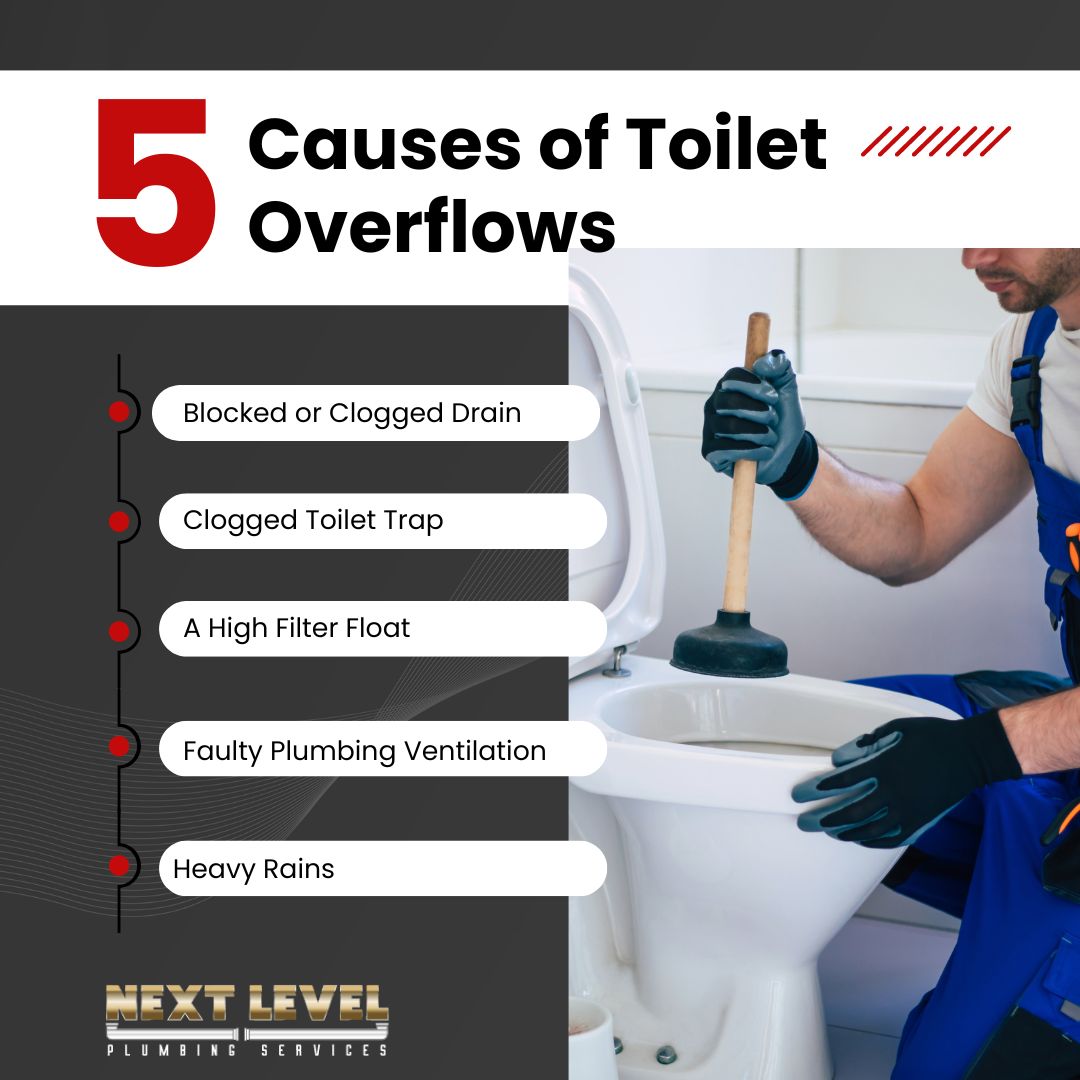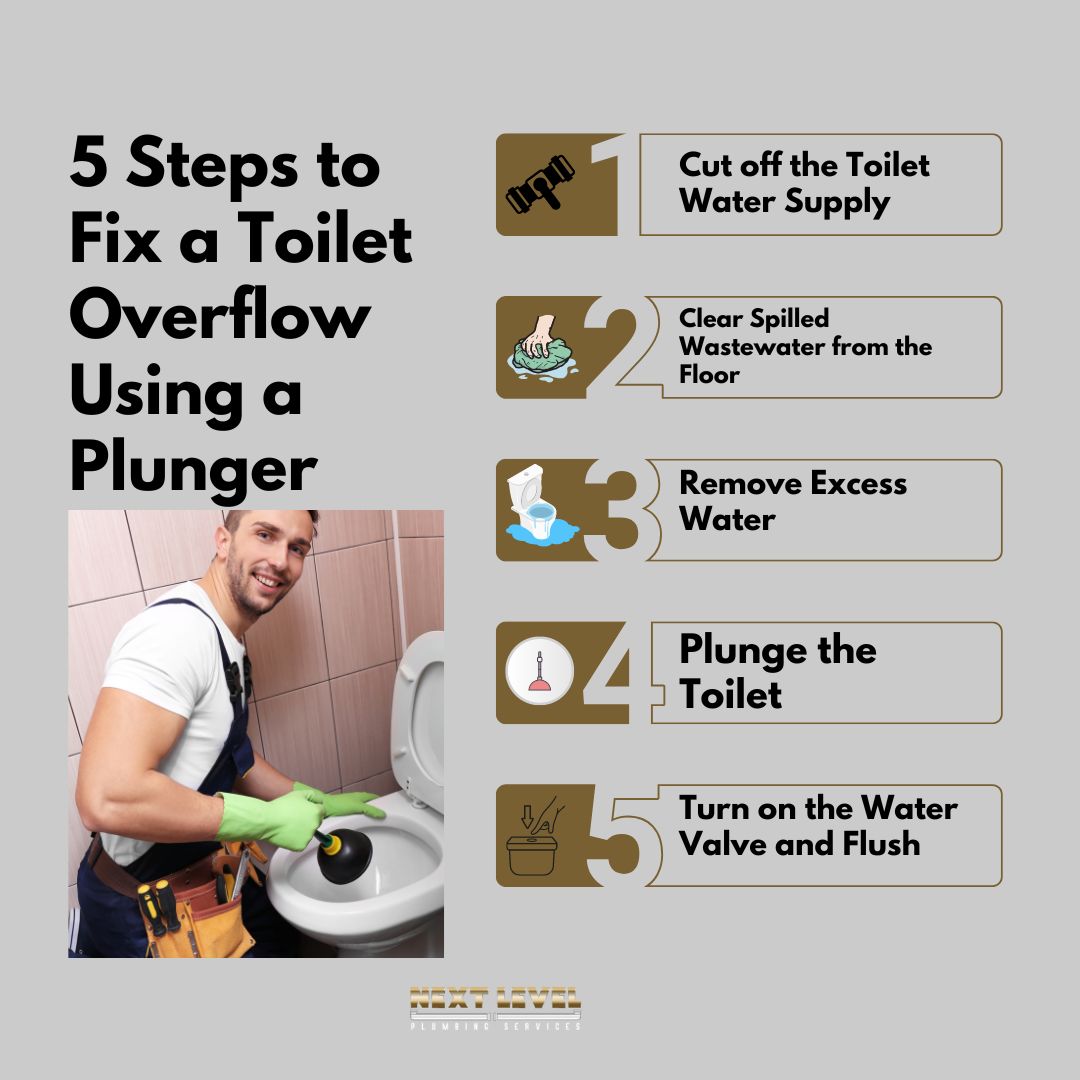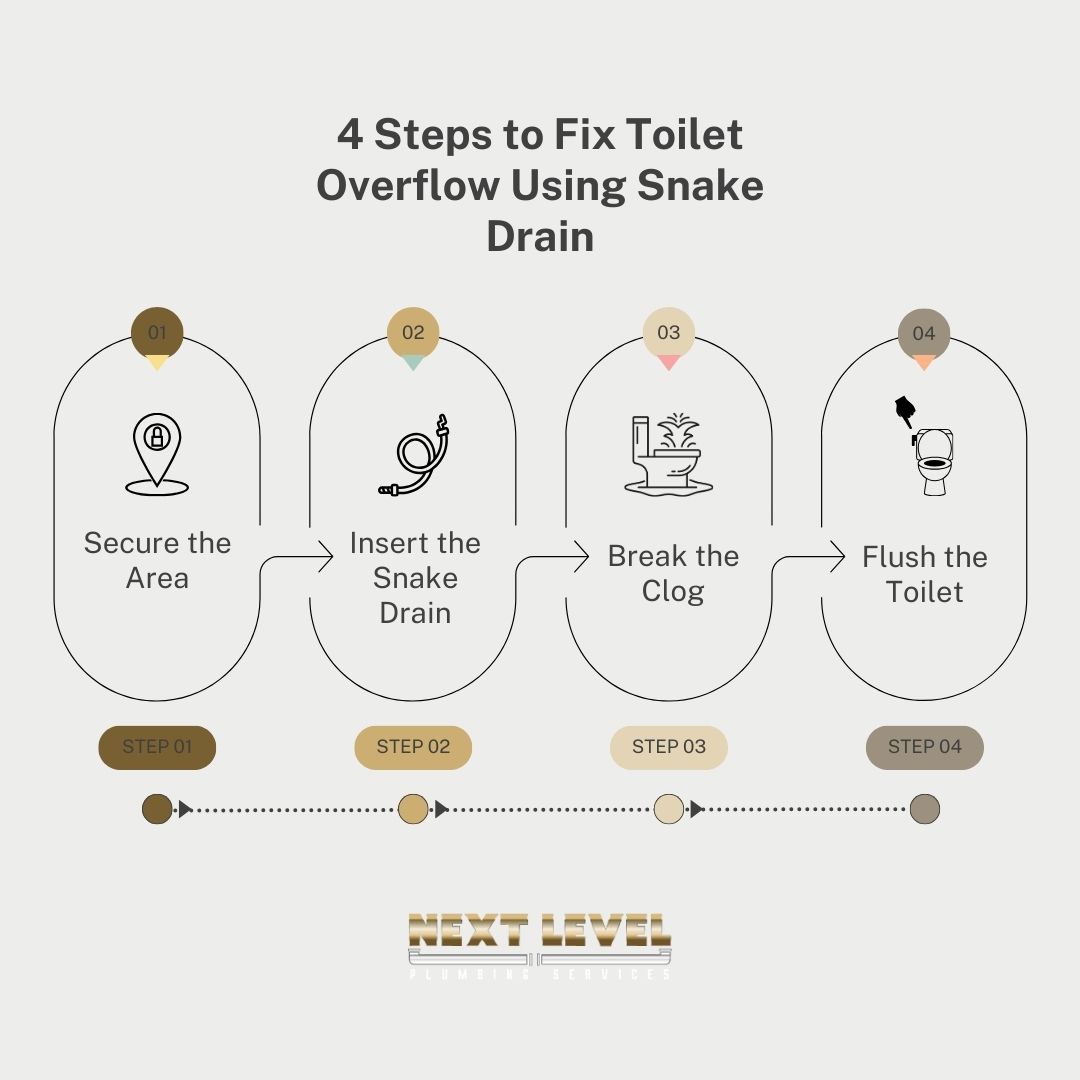An overflowing toilet is an instant nightmare for everyone. As the wastewater rises, panic hits instantly. While toilet maintenance is every homeowner’s or renter’s responsibility, sometimes even your best approach can fail, resulting in a toilet overflow. Find out what causes your toilet bowl to overflow and ways to fix this problem before it becomes a messy, hazardous affair.
Table of Contents
- What is a Toilet Overflow?
- Why Do Toilets Overflow?
- How to Fix An Overflowing Toilet
- Partner with Next Level Plumbing Services Today
What is a Toilet Overflow?
Understanding an overflow is essential before delving into why it occurs. A toilet overflow occurs when water levels from the tank rise above the bowl or rim. Contrary to popular belief, an overflow is different from a backup, which arises primarily from a clog in the drain. Nevertheless, clogs can also cause toilet overflows.
Why Do Toilets Overflow?
A functioning toilet flushes water down the toilet bowl with adequate pressure and force. The slow clearing of waste and frequent backups point to underlying problems in different components of your toilet. Here are a couple of areas that can trigger an overflowing toilet.

1. Blocked or Clogged Drain
The most common problem behind an overflowing toilet is a clogged drain line. A clogged toilet drain prevents wastewater from draining into the pipe. Water may back up as you flush, causing the toilet bowl to overflow. The obstruction prevents water from flowing freely, completely, or intermittently, resulting in slow drainage.
2. Clogged Toilet Trap
Plumbing laws require toilets to have curved piping called a trap to prevent the backflow of putrid sewer gas. You have probably seen it behind your toilet as a P or S curve. The P-trap or S-trap fitted in toilets can become trapped with toilet paper, sanitary products, or other objects, obstructing water flow and leading to an overflowing toilet.
3. A High Filter Float
The filler float regulates the water entering the toilet tank to maintain the appropriate level. If the float is too high, excessive water enters the tank, leading to overflow. If it is too low, insufficient water enters the cistern.
4. A Faulty Plumbing Ventilation System
The plumbing system has a vent pipe or stack that regulates air pressure and prevents foul odor and wastewater from backing into your home. The vent also releases pent-up gas from your sewer system and lets in fresh air. Sanitary vent lines branch from the plumbing line and run outside your property straight to the rooftop through the side wall. Obstructions from leaves, twigs, and debris can result in your toilet backing up.
5. Heavy Rains
Excessive rainfall or rapid snowmelt can lead to plumbing issues. The deluge of water can force debris into sewer lines, cause water to flow backward through pipes, or overload your property’s plumbing infrastructure with more water than it can handle. Although storm-related plumbing issues are short-lived, they can be a significant problem if they become recurrent.
How to Fix an Overflowing Toilet
The severity and frequency of the overflowing inform the best course of action for repair. Hiring a professional plumber may be your best solution. However, you can resolve one-off overflow events quickly before water leaks from your toilet bowl. Here are tried-and-tested ways to stop an overflowing toilet.
1. The Plunger Technique

Step 1: Cut off the Toilet Water Supply
As water wells up the toilet bowl, your fast course of action is to turn off the shut-off valve located on the incoming water supply line for the toilet. If you cannot see the valve, lift the cistern’s lid and push down the flapper to stop the tank from emptying. Cutting off the water flow from the cistern into the bowl prevents more water from filling and overflowing into your toilet floor.
Step 2: Clear Spilled Wastewater from the Floor
Wastewater is laden with pathogens that can contaminate your home or property as it spreads. Use throwaway rugs to clear the water, and wash your floor with disinfectant and soap to destroy germs. Removing excess toilet bowl overflow also prevents mold and mildew growth.
Step 3: Remove Excess Water
Shutting off the valve or preventing water flow from the cistern using the flapper does not eliminate the accumulated water on your toilet cistern. You may have to reduce the water in the toilet bowl by draining it into a bucket to prevent spillage.
Step 4: Plunge the Toilet
A toilet plunger is the most effective way to clear clogs down the toilet drain or trap. Plungers are designed with a broad, flat base to ensure complete coverage of the toilet drain opening. It works by creating a vacuum inside the drain and adjusting the pressure between the outer side and the inside of the drain. The variation in pressure produces a suction force that dislodges the clog inside the drain and pushes wastewater in, restoring the flow.
Step 5: Turn on the Water Valve and Flush
Once the water clears from the bowl, flush the toilet to ascertain the clog is gone. If the toilet bowl drains without overflowing, you have resolved the problem. Turn the valve off again if the toilet overflows again.
2. The Snake Drain Method
A little more complex solution entails using the snake drain. A drain snake, plumbing snake, or auger is a long, flexible cable with a coiled tip that clears drain clogs. Remember to wear protective clothing because the snake drain method is messy.

Step 1: Secure the Area
Secure the toilet area with clothes and an impermeable cover to prevent wastewater from spilling over your toilet floor.
Step 2: Insert the Snake Drain
Push the snake drain gently into the drain line until it cannot go any further. When the plumbing snake cannot move, you will have encountered the clog.
Step 3: Break the Clog
Rotate the snake drain to create enough tension to break the clog. If the clog is a known object, you can also opt to hook it and drag it out of the toilet.
Step 4: Flush the Toilet
The toilet overflow should clear once you clear the blockage. Flush your toilet to drain any debris and lingering dirt.
1. Remove Obstructions from Your Vents
Carefully access your plumbing system vent on your roof and remove any leaves, debris, webs, and dirt clogging the airways. Be careful not to push anything down the pipe because it will end up in the sewer system. A clean vent will let trapped air flow out and restore wastewater flow in your toilet drain.
2. Dish Soap, Bleach, and Hot Water
A snake drain procedure is not for the faint-hearted. If you do not have a snake drain or lack the courage to push it down your toilet drain, there is another way to clear a clog. Boil water until it is scalding hot. Mix bleach and soap and pour it down your toilet drain.
Leave the mixture to work on the clog for an hour. Flush your toilet to ascertain its disintegration. Ensure the toilet bowl overflow has drained before adding more water to prevent wastewater from flowing down your floors.
3. Fix the High Filter Float
The filter float controls the amount of water that is emptied into the bowl. You can prevent an overfill or overflow by fixing the filter float to regulate water levels in your tank.
- Step 1: Shut off the valve on the toilet supply line or adjust the flapper to prevent water from filling the toilet tank.
- Step 2: Empty the toilet cistern to make it easy to fix the filter float.
- Step 3: Locate the filter float. It is the round object attached to the fill valve. Adjust it slowly by bending its arm down.
- Step 4: Finish by testing the adjustment. Open the valve to let water in and confirm if there is an overflow or overfill.
Call a Licensed Plumber
While your efforts can go a long way in preventing an overflowing toilet, sometimes the magnitude of the problem requires more than DIY solutions. A stubborn clog, like root intrusion or solidified mass, may require the intervention of a professional plumber.
Additionally, your drain or sewer line may be compromised structurally from corrosion, a burst, extensive leaks, or years of wear and tear. Complex damages require professional sewer line rehabilitation.
Plumbers inspect the drain line and toilet before developing a solution to fix the problem. They could resolve to clear the clog using hydro jetting, which uses high water pressure to dislodge blockages deep within your sewer system. If the pipes have severe damage, the plumber may resolve to replace the entire line or a substantial portion.
Partner with Next Level Plumbing Services Today
Do you have a constantly overflowing toilet? Next Level Plumbing Services offers reliable, professional, affordable solutions to prevent recurrent toilet overflows. We have the resources, equipment, and technology to fix the problem without digging or damaging your floors. Our in-house contractors handle everything, from inspection to repairs, testing, and cleanup, leaving your toilet functioning optimally. Call us today to request a quote.

